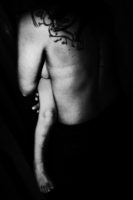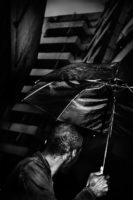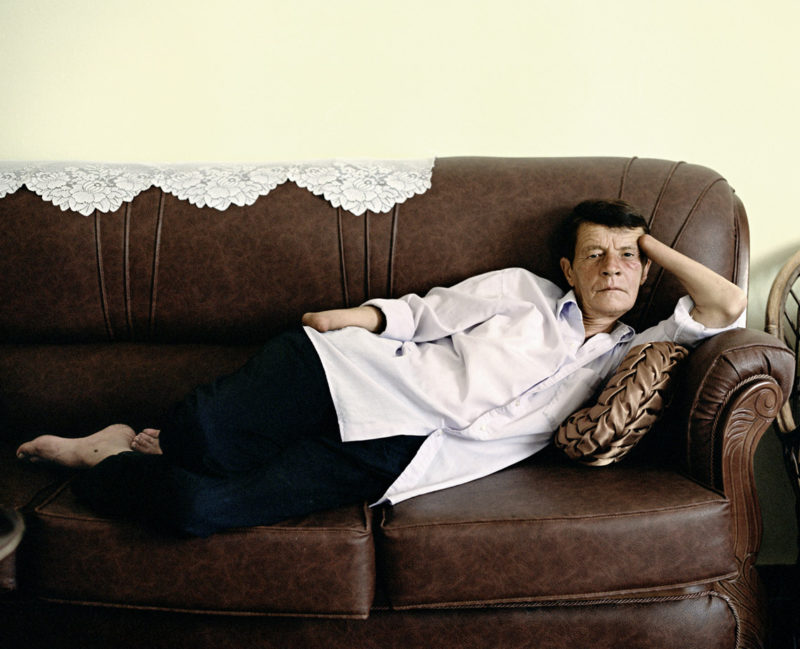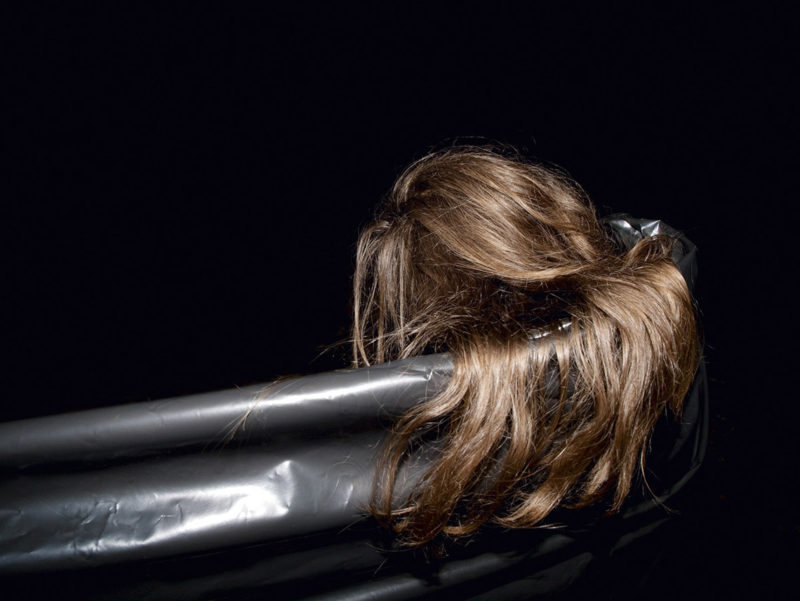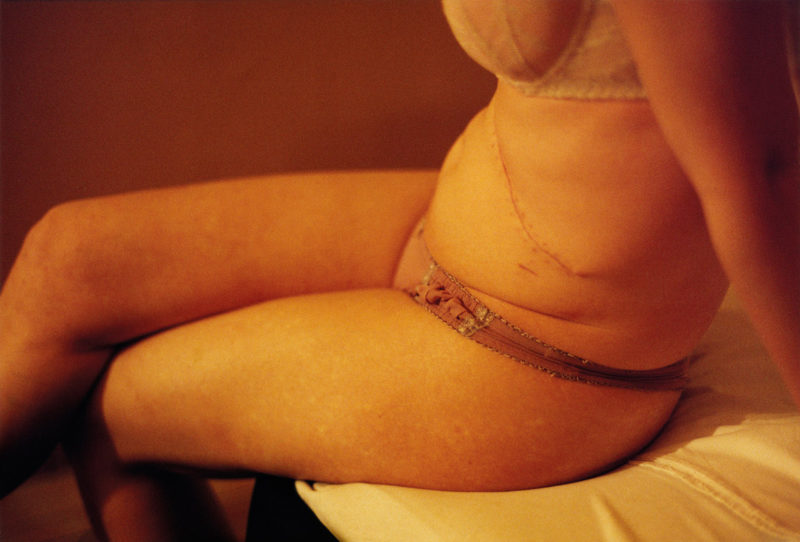Dorothee Deiss is one of the winners of the Conscientious Portfolio Competition 2013. In her statement about the work, juror Alice Rose George Rose wrote:
“I find myself going back again and again to these portraits by Dorothee Deiss. Yes, they are inherently fascinating because they show people with what seems to be some physical or mental handicap, but they don’t let you go after the initial surprise. At first they may disturb because they aren’t ‘normal’, but the sensation moves surely and quietly to acceptance and a growing curiosity. Who are these people? What do they feel? How am I to face them? They seem so brave and trusting and vulnerable. They look directly back at the photographer. It’s almost as if they would reverse the roles. The light is bright, more like an examining light than one in a formal portrait; it reveals the mistakes of the flesh but is not mean. And the background is not black, which would be harsh and drama-making, but is a light grey or neutral shade that frames the subjects comfortably — not too tight as to be imposing or distorting, not too wide as to be distancing. The quality of the image making, the surprise of discovering these individuals, and the intelligent and unflinching eye of the photographer make these photographs my choice for the Conscientious Portfolio Prize.”
I spoke with Dorothee about her ideas of portraiture and her work.
Jörg Colberg: Let’s start with a simple question first. What makes a good portrait? What is it a good portrait has that a bad one doesn’t have?
Dorothee Deiss: That’s not a simple question at all. For a long time I have been looking for the ingredients of a good portrait. In my mind a good portrait strives for honesty, truth, intensity, empathy and respect. It dignifies and makes some kind of beauty visible. It is an emotionally striking picture of somebody, where one could catch a glimpse behind the „surface“. A good portrait doesn’t denude, it keeps a secret which the viewer is able to reveal in many different ways.
Portraiture is mostly about nonverbal communication and the relationship between the subject and the photographer, as well as between the picture and the viewer. For me, it is loaded with a lot of human, social, and ethical expectations. A portrait should capture the richness, complexity, and dimensions of human experience.
These days, there are so many discussions if portraiture can still exist as an art form. In a digital world where we look at millions of facial surfaces, which have nearly nothing to do with the personalities behind them, one can argue that a portrait is always merely a mask.
However, I strongly believe in portraiture. In my daily life I depend on reading somebody’s face to understand him to some extent. Faces are vivid maps of human experience, just as good portraits can be.
Nevertheless, a portrait is not only produced by the photographer’s interpretation of someone. In addition, it is transformed by the viewer’s active interpretation, which you can think of as a kind of reinterpretation. With each reinterpretation, it is if the portrait is being recreated.
You can tell a lot about a person from their face, but the way we perceive that face and body also tells a lot about ourselves. Our own prejudices have to be questioned the moment we look at somebody’s face. I have been frequently accused for exposing someone as a freak. But to what extent do we project ourselves when we consider a portrait as a caricature because we cannot deal with our own awkwardness?
In the communal and safe setting of an art gallery or in photobooks viewers can engage with pictures to articulate the most basic of human fears roiling inside them. Therefore, there could be the opportunity that by seeing portraits our ability to think and to see more in general is changed, to see the strange in the familiar.
Portraiture is not a cold and voyeuristic method to get excited about the aberrant, about deformity and marginality. In fact, it provides a safe mechanism to explore, contemplate and experience our own terrifying feelings concerning health or illness, disfigurement and death from afar. Thus, from a distance the viewer can better deal with threads or blemishes the subject in a portrait have to deal with. But at the same time these threads or blemishes are archetypical of our own human experience, of life. Portraits allow the viewer to imagine the unimaginable. This might not serve only for the viewer’s self-acceptance, but also for producing empathy.
With my pictures, I hope to get the viewer into an emotional engagement, to induce compassion, human and social interest for people who do not necessarily fit into a perfect world.
It is important to use the formal aspects in a portrait to express these complex interrelations. I often struggle with creating enough simplicity and formal similarities between different portraits, to sort out the essential features that will make the meanings of the photographs visible, meanings that might otherwise be lost in the process of unpacking less well-structured presentations.
JC: You mentioned two things you essentially need to work against, namely some viewers accusing you of exposing people as freaks. The freaks accusation is an old one, and you’re in good company even though I’m not sure it’s a company you enjoy being in. So I want to ask you about this: What do you make of Diane Arbus’ portraits? How do you see them in relation to yours?
DD: Although I do not feel strongly influenced by Diane Arbus’ work, I cannot ignore the conflicting discourses of her legacy, mainly concerning the subjects of her photographs and her relationship to them. This has a lot to do with my own questions and considerations concerning “misfit models.” Arbus was called the “photographer of freaks,” and her work has been evaluated based on moral and psychological terms concerning her as a person, but less because of the work itself.
It is said in Arbus’ defense that deformity did not interest her, when of course it did. And this is the same for me. What is essential to understanding her pictures as well as mine is that deformity interests us not as a blunt, obscene fact, but for how it has shaped the psyche of the person who has endured it. Diane Arbus once stated
“Most people go though life dreading they’ll have a traumatic experience. Freaks were born with their trauma. They’ve already passed their test in life. They’re aristocrats.”
I do not like to call somebody as a freak. But I agree with Diane Arbus that people who have to struggle with a traumatic experience gain and mature with this experience, provided they are willing to look into it. And, like Arbus, I want to show people who are not afraid of existing the way they are, regardless of any generalizations or stereotypes about them.
Like Arbus’ portraits, pictures of people at the fringes of our society often seem to be provocative, because they raise disturbing questions about the relationship between photographer, subject, and audience. They implicate all three parties and the ethics of vision itself. Our license to have the experience of viewing another person might be changed and challenged, supported and enriched.
JC: You also mentioned that there are all those photographs on Facebook, many of them portraits, that, you say, “ have nearly nothing to do with the personality behind” them. I am very familiar with art photographers dismissing photography shown on Facebook, which, I think, is a very big mistake. After all, why would someone post a picture if it had “nothing” to do with them? Aren’t all those people doing exactly what you are doing yourself, namely taking a photograph that expresses an idea, their idea, of a person?
DD: I mentioned the digital world of pictures in general. However, Facebook is a good example of how people try to define themselves by posting endless pictures of their expressions, food, emotions etc. You are totally correct, those people express their ideas about themselves and others. There’s nothing wrong with that at all. But I cannot keep up with the speed of their digital publishing, it leaves me breathless. As if nobody took the time any more to think about themselves or somebody else before already posting the next picture! It’s like to be on stage and to randomly throw millions of pieces of their personal puzzle into the audience, like an unreflected striptease. I cannot imagine that anybody would seriously think that this could generate a complex portrait. What is more, there is not much room for conversation. You can “like” it or briefly “comment” on it. That is often not enough to build up a relationship between the model and the viewer.
Nevertheless, I agree that the internet has to be (and fortunately is already) a big part of making art accessible to a larger public. That is democracy.
The internet per se is not the culprit of portraits that “have nearly nothing to do with the personality behind” them. The real reason is that in our present world the outer surface is so much more important than the content.
“With my pictures, I hope to get the viewer into an emotional engagement, to induce compassion, human and social interest for people who do not necessarily fit into a perfect world.” – Dorothee Deiss
JC: How do you try to bring your ideas of what a good portrait is and does to your own work, when you photograph someone?
DD: First of all, I have to be honestly interested in the other and be open myself as well. A portrait can only reflect human expression when there is a gracious relationship with the model, a mutual give-and-take.
Before the shoot I always start a conversation with the model, so we can become more familiar with each other. I try to get a rough picture of somebody’s circumstances of life, of important issues and problems he has to deal with, watching his facial expressions and gestures. Portraits are constructed and shaped through the development of productive and benign relationships, where trust is built and intimacy negotiated.
For VisibleInvisible, I worked in the studio for the first time. This gave the opportunity to take more time for a shoot, to create a certain safety zone for the model and me. You might compare it with what happens a psychotherapist’s office. You can let go of your facade, you can scream, cry, grieve, confess your weaknesses. And when you leave, everything stays there, in a safe place. In photography, there is the photograph left as a witness of what happened in this “artificial“ space between the model and the photographer. However, after the shoot, the model can decide to step back, to distance himself from the picture and leave it as „something and somewhere else“ .
During the process to get the „perfect portrait“ I strive for as much honesty and openness as possible between me and the model, with the idea of getting an intense and touching picture. Now I think the picture is a compromise between the search for an „inner truth“ and what I make the sitter to be. In other words, the portrait does not have to capture the model how he sees himself. Of course, it should capture some kind of essence. This could be qualities of his character and history, some of which he is unaware of, some of which he resists, some of which feel deeply familiar.
I think doing portraits is also crucial for my own self-reflection and self-understanding, which is growing out of the relationship between the other person and me. It is in our genuine encounters with what is other and alien that we further our understanding of our self.
In the situation where I take a portrait, the relationship between my model and me works towards self-understanding in two different ways. I can learn from the people I am allowed to photograph. I can learn how they manage their lives with all the challenges, to find gratitude of and confidence in my own incompleteness. On the other hand, the model can learn from the mirror that is held up, from the telling of one’s story through another person’s voice. My hope is that if a portrait is authentic, there is something to recognize in the portrayal that is at the heart of the model’s experience.
Sarah Lawrence-Lightfoot perfectly described the different roles of a portraitist and meanings of portraiture:
“I am a mirror that reflects back their pain, their fears, and their victories. I am also the inquirer who asks sometimes difficult questions, who searches for evidence and patterns. I am the companion on the journey, bringing my own story to the encounter, making possible an interpretative collaboration. I am the audience who listens, laughs, weeps, and applauds. I am spider women spinning their tales. Occasionally, I am a therapist who offers catharsis, support, and challenge, and who keeps track of emotional mine fields. Most absorbing to me is the role of human archeologist who uncovers the layers of mask and inhibition in search of a more authentic representation of life experience. Throughout, I must also play stage manager, coordinating the intersection of three plays, the storyteller’s, the narrator’s, and the perceiver’s, inviting you to add your voice to the drama“.
JC: How do you decide about models/subjects? How do you find them?
DD: I cannot exactly define the characters I am looking for. It’s a question of sympathy, something in their faces, in their charisma, that catches my interest. I am frequently asked why I choose these kinds of people, and I am being criticized for exposing them as freaks. In my mind, I search for an intimacy with these people because there is an affinity with them, a feeling of awkwardness and insecurity.
I met Marie, the girl with the burned skin, at a casting for misfit models, where she applied. I was impressed with her confidence and the natural way of living with her burden, her ease when getting photographed. What makes all these people special is that they are all confident in showing themselves despite the fact that they don’t fit into our society. But they are not freaks, they are individuals like all of us.
I believe in the unseizable complexity of everybody’s personality. To picture that in a photograph is impossible. However, I want to mediate at least an idea of this complexity in my portraits.
JC: And then how do your models react when they see the photographs you took of them? Do you show them? Is it important for you to learn about their reactions?
DD: It is always a difficult moment when I show them the pictures. The situation reveals so openly what people in general expect when they look at a photograph. They want to see a professionally made, flattering, pleasant portrait where the real is beautifully painted over. Of course, given my models experienced the shoot, knowing my intentions and what I wanted to get out of them, they try to understand the resulting photograph. Some of them are ready to see the strange in the familiar, to discover something new in themselves. But often they are a bit alienated, sometimes disappointed. Although I understand that, it hurts me. However, it is important to confront myself with their reaction. It can mean different things. It can either mean that they are not willing or able to accept the truth in what they see, or that the portrait is only a distortion of my own imagination and has nothing to do with the person I intended to understand.
Therefore, I always try to make “nice” pictures at the end of the shoot, where I encourage the models to behave and pose how they want to see themselves in a photograph. It is understandable that they want to get pictures which they can proudly show their family and friends, photographs in which they don’t have to reveal any weakness, back in their strong armor.
, a book that contains photographs of things or concepts or ideas you seemingly cannot depict. The reality, of course, is that given there are photographs in the book, apparently the book seeks out to undermine its own premise. It does, and it doesn’t. In five separate chapters, The Unphotographable presents images of things that can’t be photographed for all kinds of reasons, whether it’s given they don’t actually exist (like ghosts), they’re completely abstract, they subvert the medium itself, etc.



